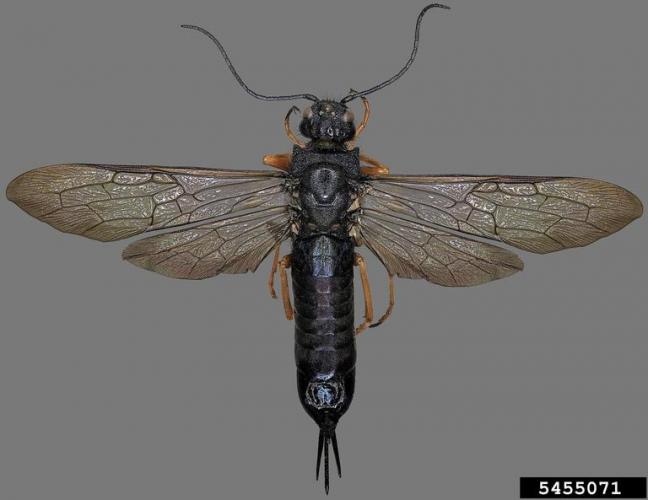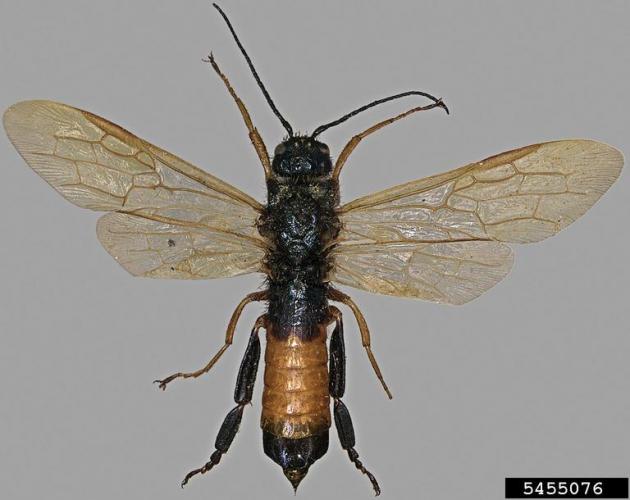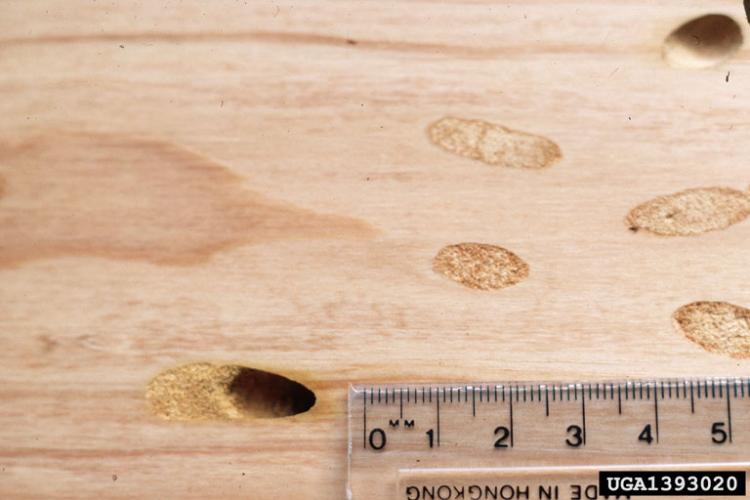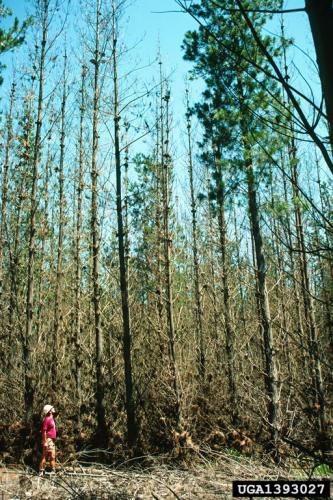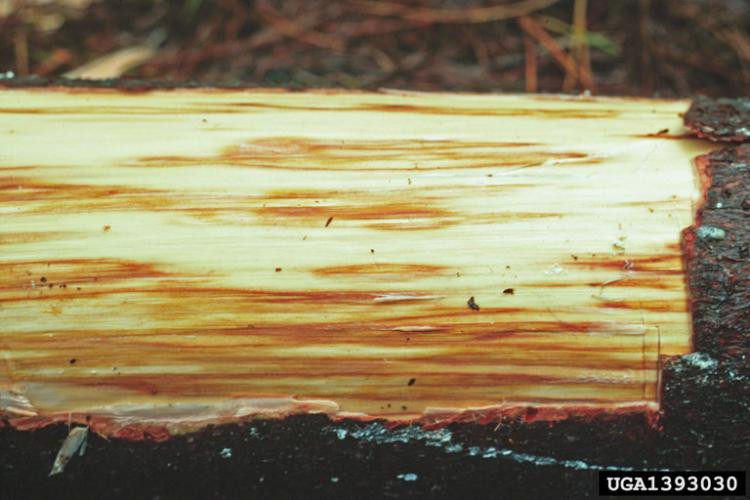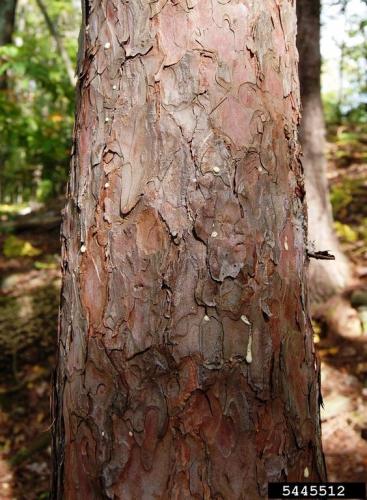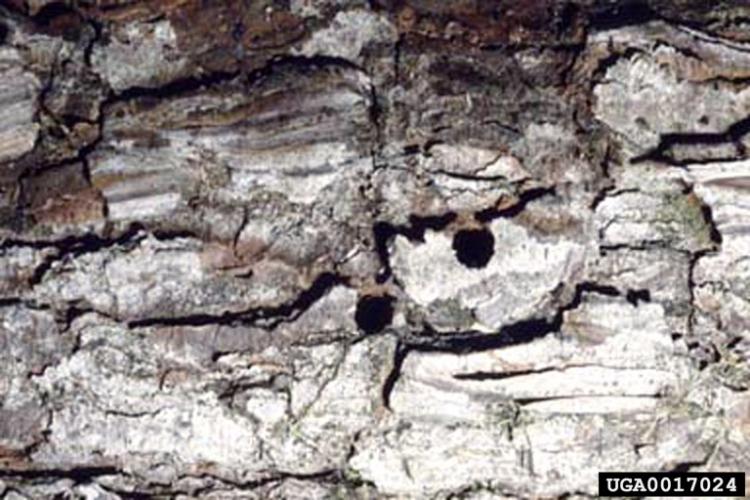Sirex Woodwasp
Identification
Woodwasps are large insects, usually 1 to 1.5 inches long. Adult wasps have four, clear, yellow membraneous wings and their antennae are entirely black. Males and females have stout, cylindrical bodies with a pointed abdomen. Females also have a spike-like projection on their abdomen which protects their ovipositor. Males have thick, black hind legs and orange/yellow middle segments on their abdomen. Females have reddish-brown legs and a steel-blue body.
signs and symptoms
- Larval galleries packed with chewed wood and fine, powdery frass
- Circular exit holes, 3-8 mm wide
- Resin flowing from oviposition holes
- Needles turn yellow or reddish brown
- Stem growth is dramatically reduced
- Mortality will occur heavily infested trees
See image slideshow above for signs and symptoms.
Biology
Origin
Sirex woodwasp, Sirex noctilio, is an exotic wood-boring insect native to Europe, Asia, and northern Africa. This insect has been the most common species of exotic woodwasp detected at United States ports-of-entry associated with solid wood packing materials. Recent detections of Sirex woodwasp outside of port areas in the United States have raised concerns because this insect has the potential to cause significant impacts on southern and western pines. In the northeast, it has most commonly attacked stressed Scots pine and red pine but has infested eastern white pine as well.
Sirex woodwasp was first discovered in the United States in 2002, in Indiana. Based on its native range in Europe and Asia, it could establish itself in any climate zone of North America where pine occurs.
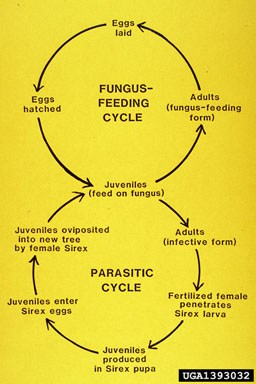
Life Cycle
- One generation per year
- Adults emerge July-September
- Females are attracted to stressed trees. They drill their ovipositor into the outer sapwood to inject a symbiotic fungus, toxic mucus, and egg.
- The fungus and mucus work together to kill the tree and create an environment ideal for larval development.
- Females can lay anywhere between 25 - 450 eggs
- Unfertilized eggs develop into males. White, fertilized eggs become females.
- All larval instars feed on the fungus as they tunnel through the wood.
- There are approximately 6-12 instars and the larval stage takes 10-11 months. Mature larvae pupate close to the bark surface.
- Adults emerge three weeks after pupation.
Ecological threat
Sirex woodwasp is considered one of the top 10 most serious forest insect pests worldwide. These woodwasps attack living pine trees and, in areas where they have been introduced, have caused extensive losses.
Sirex woodwasp has been successfully managed using biological control agents, primarily a parasitic nematode (Deladenus siricidicola) which infects sirex woodwasp larvae and, ultimately, sterilizes the adult female. These infected females emerge and lay infertile eggs that are filled with nematodes, thus spreading and sustaining the new nematode population. The nematodes effectively regulate the woodwasp population below damaging levels.
In addition to the nematode, hymenopteran parasitoids have been introduced into sirex woodwasp populations in the Southern Hemisphere, and most of them are native to North America (these include: Megarhyssa nortoni, Rhyssa persuasoria, Rhyssa hoferi, Schlettererius cinctipes, and Ibalia leucospoides).
Vermont Distribution
Sirex woodwasp has been confirmed in parts of Vermont.
Citations
Photo Credit
Carrie Crook, Bugwood.org
Dennis Haugen, Bugwood.org
Steven Valley, Oregon Department of Agriculture, Bugwood.org
William M. Ciesla, Forest Health Management International, Bugwood.org
Information Credit
Canadian Food Inspection Agency
Center for Invasive Species and Ecosystem Health
National Invasive Species Information Center
New York Invasive Species Information
